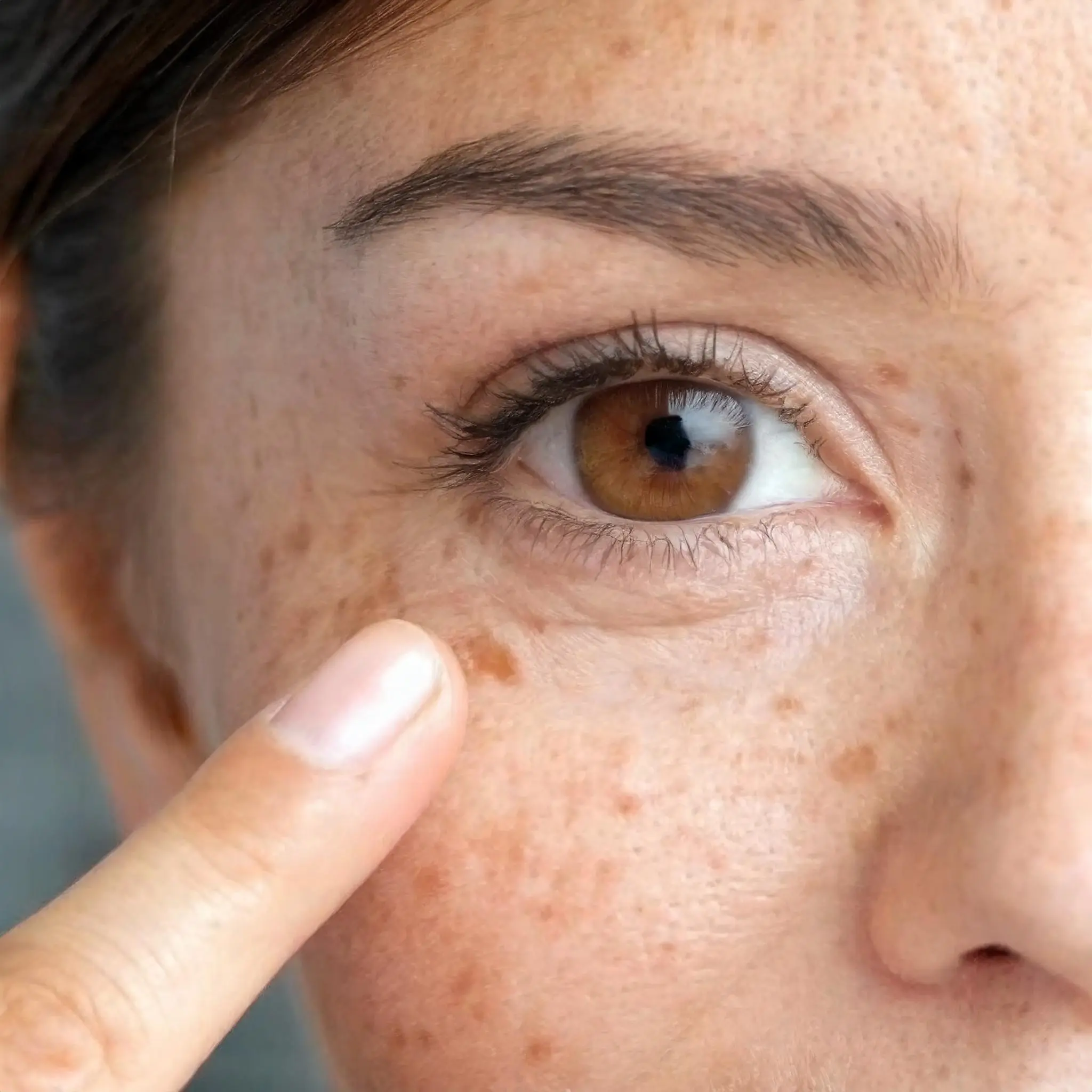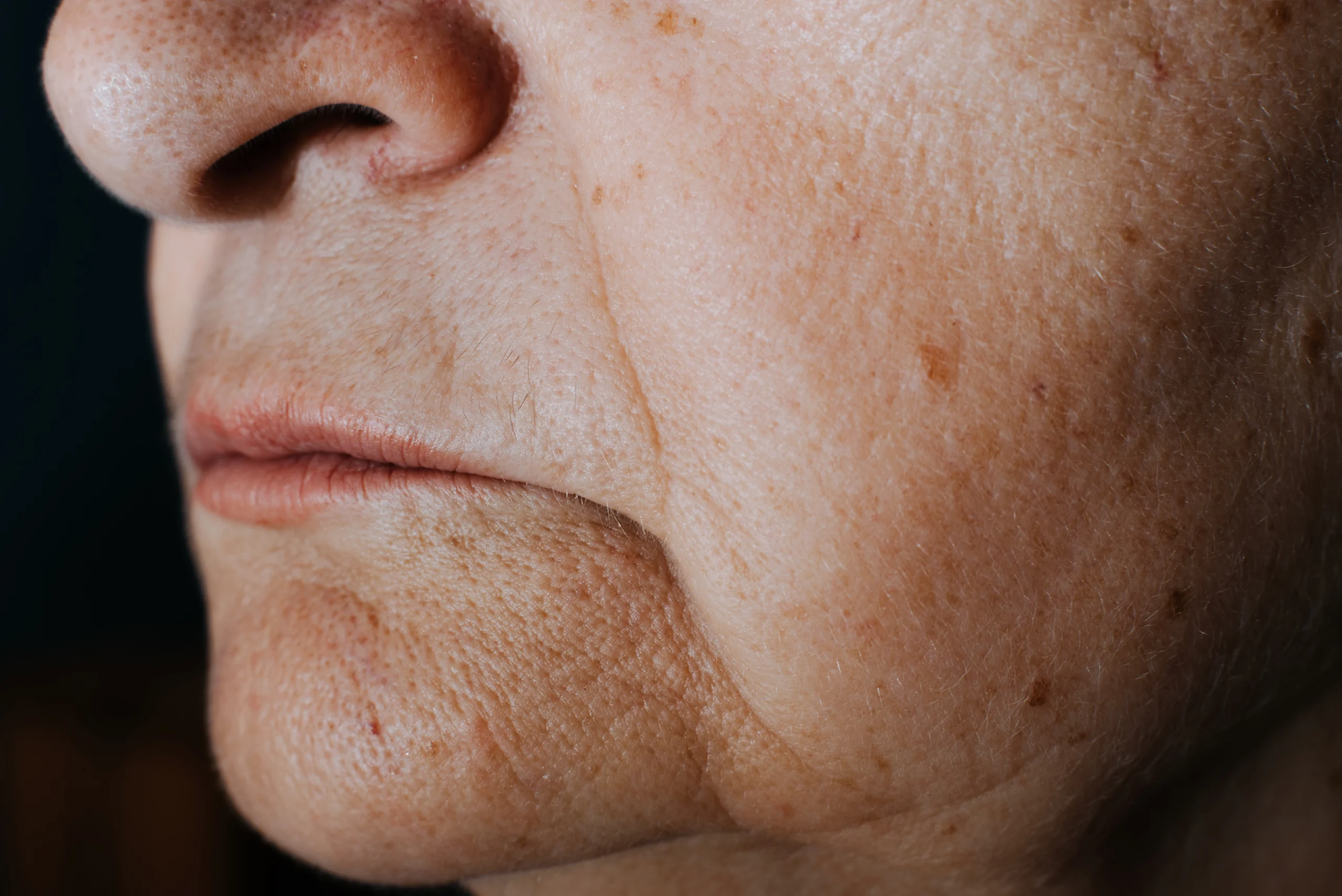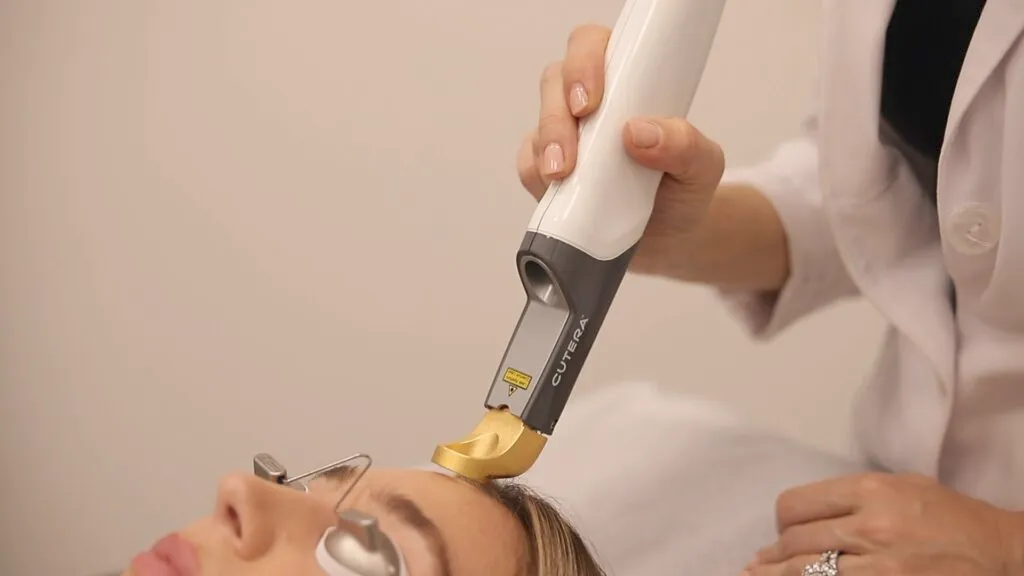
Age Spots Removal
Age spots, also commonly referred to as liver spots, are brown spots that can emerge as individuals age. These blemishes typically appear as flat brown spots and are often found on areas of the skin that have been exposed to the sun over the years, such as the face, hands, arms, and shoulders. While age spots are typically harmless, they can be a cosmetic concern for many people. This comprehensive guide will provide valuable insights into the causes of age spots, risk factors, prevention strategies, and effective treatment options. We will also explore the differences between age spots and other skin issues, offering professional guidance to help you make informed decisions about your skin health.
What are age spots
Age spots, known by various names such as liver spots, sun spots, brown spots and dark spots are flat, benign brown spots that usually manifest as small, darker areas on the skin’s surface. These spots can range in color, typically appearing as shades of brown. They are most commonly found on parts of the body that have been exposed to the sun’s UV (ultraviolet) rays over time. These areas include the face, hands, arms, and shoulders. Although age spots are typically benign and do not pose any medical concerns, their appearance can be a cosmetic issue that prompts individuals to seek treatments for their removal.
What causes age spots
Age spots predominantly develop due to prolonged exposure to the sun and the adverse effects of ultraviolet (UV) radiation. Over time, the sun’s UV rays stimulate an increase in the production of melanin, the pigment responsible for determining skin color. In the case of age spots, an excess of melanin accumulates in specific areas of the skin, leading to the formation of these brown spots. The natural aging process can also contribute to the development of age spots, as the skin’s ability to regenerate and repair itself decreases with age. This results in the gradual appearance of these spots. Age spots, liver spots on skin, sun spots on skin and dark spots on face are very common for older individuals who have prolonged exposure to the sun.
Risk Factors
Certain factors can increase an individual’s risk of developing age spots on face and black spots on skin. Those with fair or light skin are more prone to these blemishes, as their skin contains less melanin, making them more susceptible to the effects of UV radiation. Frequent and prolonged sun exposure without adequate sun protection measures can also heighten the risk of age spot development. Additionally, genetic factors can play a role, as some individuals may have a genetic predisposition to develop age spots. It is essential for individuals with these risk factors to take extra precautions to prevent age spot formation.
At FCP Dermatology we offer a wide range of surgical and cosmetic Dermatology services, in a 5-star luxury setting.
- +1 (416) 861-8600
- Contact via Email
Age Spots Treatment
Pico Genesis
All Natural Green Peel
Related Aging and Skin Concerns
How to Prevent Age Spots
Preventing age spots requires adopting sun-safe practices that minimize the risk of UV radiation damage. To reduce the likelihood of liver spot, sun spot and age spot formation, consider the following prevention strategies:
- Use Sunscreen: Apply broad-spectrum sunscreen with a minimum SPF of 30 to all exposed skin, even on cloudy days. Reapply every 2 hours, especially when engaging in outdoor activities.
- Use a vitamin C serum every morning, ideally 15% L-ascorbic acid
- Use Retinol every night before bed
- Wear Protective Clothing: Shield your skin from the sun by wearing wide-brimmed hats, long-sleeved shirts, and sunglasses that block UV rays.
- Seek Shade: Minimize sun exposure during the peak hours of UV radiation, typically between 10 a.m. and 4 p.m.
- Avoid Tanning Beds: Tanning beds also contribute to UV damage, increasing the risk of age spot development and skin cancer. It is advisable to steer clear of them.
Age Spots vs Skin Cancer
Age spots are often mistaken for other skin conditions, including freckles, moles, and even melanoma and skin cancer. It is essential to see a Board-Certified Dermatologist to treat your sun spots as they are the only physicians that can correctly identify age spots and distinguish them from skin cancer.
- Age Spots vs Freckles: Freckles are small, light brown spots that tend to appear in sun-exposed areas. Freckles tend to have an earlier onset than sun spots.
- Age Spots vs Moles: Moles, also known as nevi, can be raised or flat, and they may vary in color. Moles are typically present before the age of 30, whereas sun spots develop over time due to sun exposure or aging. If you’re interested in learning more about moles and mole removal visit: Surgical Mole Removal
- Ages Spots vs Melanoma: Age spots, caused by sun exposure, are benign flat patches of skin, while melanoma, originating from melanocytes, is a potentially deadly form of skin cancer, characterized by irregularly shaped moles that can change over time and require prompt medical attention for early detection and treatment
- Age Spots vs Skin Cancer: Skin cancer lesions can resemble age spots, only a Dermatologist is qualified to distinguish skin cancer from a sun spot. It is vital to consult a dermatologist for treatment of any age or sun spots.
Age Spots, Sun Spots and Liver Spots
Professional Consultation
For a proper diagnosis and personalized treatment plan, consulting a Dermatologist is crucial. A dermatologist possesses the expertise to accurately evaluate age spots, rule out any underlying skin issues, and recommend the most appropriate treatment. During a professional consultation, at a Dermatology clinic, the type and severity of sun spots will be examined, and your treatment options discussed to ensure that the chosen treatment aligns with your skin type and preferences. Consulting a Dermatologist’s office is the most reliable path to achieving safe and optimal results.

The best way to get rid of age spots
Age Spots Removal Treatment
Effective treatment options are available for sun spots, catering to various preferences and skin types. These treatments aim to diminish the appearance of sun spots and achieve a more even skin tone. While these treatments can be effective, it’s essential to consult a dermatologist to determine the most suitable treatment based on the type and severity of your age spots. A dermatologist will also ensure that there are no underlying skin issues that require attention.
Common treatment options:
- Topical Treatments: Professional-strength topical treatments containing ingredients like hydroquinone, retinoids, or glycolic acid can help fade age spots gradually. The best place to purchase these are at a Dermatologist’s office after a consultation on which cream is right for you.
- Chemical Peels: Chemical peels involve applying a chemical solution to the skin, which exfoliates the top layer to reduce the appearance of age spots.
- Natural Peels: The Green Peel is a completely natural herbal peeling treatment that regenerates the skin and lifts pigment away from the skin.
- Light Therapy: Intense-pulsed light or IPL is commonly used to treat sun spots, although it is not as effective as PICO laser and cannot be done on all skin types. PICO laser is the gold standard for sun spots and brown pigmentation on all skin types.
- Laser Therapy: Laser treatments, specifically PICO lasers use focused laser energy to target and break down the excess melanin in age spots. PICO laser can be used on all skin types safely. Multiple sessions may be required for optimal results.
- Cryotherapy: Cryotherapy involves freezing age spots using liquid nitrogen. This causes the spots to peel away as the skin heals.
Getting rid of Age Spots
Remove age spots at home
In addition to professional treatments, such as laser therapy, green peels or chemical peels, numerous home remedies and over-the-counter products are marketed to fade age spots. However, many of these remedies lack scientific evidence and may even exacerbate sun spots or cause skin irritation. For safe and effective removal of age spots, it’s crucial to consult with a dermatologist who can accurately diagnose the condition and recommend appropriate treatment options tailored to your specific needs. Booking a consultation with a dermatologist ensures that you receive expert guidance and personalized care, leading to optimal results in addressing age spots and achieving healthier, clearer skin.

Age Spots FAQ
Frequently Asked Questions about Age Spots
Liver spots, also known as age spots or solar lentigines, are flat, brown spots that develop on the skin due to prolonged sun exposure and aging. They commonly appear on areas frequently exposed to the sun, such as the face, hands, and arms.
How to remove brown spots on face?
Liver spots, also known as age spots or solar lentigines, are caused by prolonged sun exposure and aging, which lead to an increase in melanin production and the development of dark spots on the skin.
Freckles are small, concentrated spots of pigment that develop as a result of genetics and sun exposure. They are triggered by an increase in melanin production
How to get rid of age spots: Age spots, also known as liver spots or solar lentigines, can be treated with options such as topical bleaching creams, cryotherapy, laser therapy, chemical peels, and microdermabrasion.
How to get rid of dark areas on face: Dark spots on the face can be treated with various methods, including topical creams containing ingredients like hydroquinone or retinoids, chemical peels, laser therapy, and microdermabrasion.
How to get rid of brown spots on face: Brown spots on the face can be treated with options such as topical bleaching creams, chemical peels, laser therapy, and microdermabrasion, which can help reduce the appearance of hyperpigmentation.
Natural remedies for age spots include applying lemon juice, apple cider vinegar, aloe vera, or vitamin E oil to the affected areas. However, effectiveness can vary, and it's essential to consult a dermatologist for proper guidance.
Despite their name, liver spots have no connection to liver health. They are simply a common sign of sun-induced skin damage and aging.
Yes, age spots and sun spots are essentially the same thing. They are both terms used to describe flat, brown or grayish patches that appear on the skin, particularly in areas exposed to the sun, such as the face, hands, arms, and shoulders. These spots develop due to an accumulation of melanin, the pigment responsible for skin color, as a response to UV exposure over time. While some people may use the terms "age spots" and "sun spots" interchangeably, they refer to the same phenomenon of hyperpigmentation caused by sun damage and aging.
Cancerous sun spots, or potentially cancerous lesions, may exhibit certain characteristics that differ from benign sun spots. These characteristics, often referred to as the ABCDEs of melanoma, include:
A: Asymmetry - One half of the spot does not match the other half.
B: Border irregularity - The edges of the spot are irregular, notched, or blurred.
C: Color variation - The spot may have various shades of brown, black, or other colors, or it may appear red, white, or blue.
D: Diameter - The spot is larger than the size of a pencil eraser (about 6mm) or is growing in size.
E: Evolution - The spot changes over time in size, shape, color, or elevation, or it becomes symptomatic, such as itching or bleeding.
It's important to note that not all cancerous spots will exhibit all of these characteristics, and some benign spots may display similar features. If you notice any changes in your skin, including the appearance of new or changing spots, it's crucial to consult a dermatologist for evaluation and proper diagnosis.
Preventing age spots primarily involves minimizing exposure to ultraviolet (UV) radiation from the sun and adopting healthy skincare habits.
Age spots typically do not grow or change significantly in size over time. Once they have formed on the skin, they tend to remain stable in size and appearance, although they may darken or become more pronounced with continued sun exposure or as a result of aging. While age spots themselves do not grow, it's essential to monitor any changes in the size, shape, color, or texture of skin lesions, as these changes could indicate more serious skin conditions, such as melanoma. If you notice any unusual changes in your skin, it's important to consult a dermatologist for evaluation and appropriate management.
Sun spots typically do not go away on their own. Once they have formed on the skin, they tend to persist unless treated. However, with appropriate treatment and preventive measures, the appearance of sun spots can be minimized or faded over time. Treatment options for sun spots include topical bleaching agents, chemical peels, laser therapy, cryotherapy, and microdermabrasion. It's important to consult a dermatologist to determine the most suitable treatment approach based on the severity of the sun spots and individual skin characteristics. Additionally, practicing sun-safe habits such as wearing sunscreen, seeking shade, and wearing protective clothing can help prevent the formation of new sun spots and reduce the risk of existing ones worsening.
The frequency of professional treatments for age spots depends on the specific treatment method used and the individual's skin response. Some treatments may require multiple sessions spaced several weeks apart for optimal results.
While diet and nutrition play a role in overall skin health, there is limited evidence to suggest that specific dietary factors directly impact the appearance of age spots. However, maintaining a balanced diet rich in antioxidants, vitamins, and hydration can support skin health and may contribute to a more radiant complexion.
Common misconceptions about age spots include beliefs that they can be completely prevented, that natural remedies are always effective, or that all age spots are harmless. It's essential to seek accurate information from reliable sources and consult with a dermatologist for personalized advice and treatment options.
